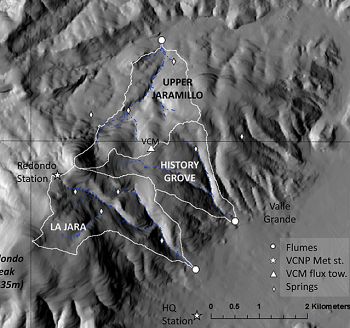Zapata-Rios et al., 2016
Influence of terrain aspect on water partitioning, vegetation structure, and vegetation greening in high elevation catchments in northern New Mexico
Zapata-Rios X., Brooks P.D., Troch P.A., McIntosh J. and Guo Q. (2016)
Ecohydrology 9(5): 782-795 Cross-CZO National
-
Catalina-Jemez, GRAD STUDENT
-
Catalina-Jemez, INVESTIGATOR
-
Catalina-Jemez, INVESTIGATOR
-
Catalina-Jemez, INVESTIGATOR
-
National, Sierra, COLLABORATOR
Abstract
First-order study catchments: La Jara, History Grove and Upper Jaramillo originate on different aspects of the highest peak (Redondo Peak).
We investigated vegetation structure, water partitioning dynamics and vegetation greening from 2000 through 2012 in three catchments draining north and east aspects of Redondo Peak in northern New Mexico. Vegetation structure was quantified from 1 m LiDAR data while vegetation greening using remotely sensed NDVI. Hydrological partitioning at the catchment scale was estimated with a metric of catchment-scale water fluxes and vegetation water use (Horton index; HI). The predominantly north facing catchment, when compared to the other two eastern catchments, receives less solar radiation, and exhibits less forest cover and smaller biomass, has more surface runoff (~15% of P) as a consequence of a smaller vaporization (85% of P) and smaller vegetation water consumption (HI = 0.85). Moreover, the north facing catchment showed smaller peak NDVI values (5.98) and shorter growing season length (121 days) as a consequence of energy limitation. In contrast, the two eastern catchments receive larger solar radiation, have more biomass and forest cover (>76%), and smaller surface runoff (<10% P), higher vaporization (>90%P) and vegetation water consumption (HI = 0.95). The eastern catchments had larger vegetation greening (6.28-6.58) and a longer growing season (148–160 days). Snowpack conditions, such as maximum SWE and duration of the snow on the ground, explain over 95% of water partitioning (HI) that in turn influenced annual vegetation greening (R2 = 0.48 - 0.67; p < 0.05). This catchment scale study in perennial streams indicates that terrain aspect at a similar altitude (2700 – 3435 m) strongly controls energy, water distribution, and vegetation productivity in high elevation ecosystems. This article is protected by copyright. All rights reserved.
Citation
Zapata-Rios X., Brooks P.D., Troch P.A., McIntosh J. and Guo Q. (2016): Influence of terrain aspect on water partitioning, vegetation structure, and vegetation greening in high elevation catchments in northern New Mexico. Ecohydrology 9(5): 782-795. DOI: 10.1002/eco.1674
 This Paper/Book acknowledges NSF CZO grant support.
This Paper/Book acknowledges NSF CZO grant support.
Explore Further






